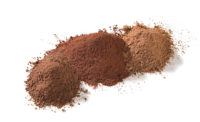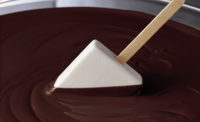Meet the panel
Gabriella Mahnke, beverage scientist, FONA International Inc., Geneva, Ill.
John Pimpo, sales manager – East, Gertrude Hawk Ingredients, Dunmore, Pa.
Stacy Reed, technical service representative, Cargill Cocoa & Chocolate, Lititz, Pa.
Dana Sanza, flavorist, FONA International Inc.
Rick Stunek, marketing & sales, Forbes Chocolate, Broadview Heights, Ohio
Rebecca Wagner,business unit manager, FONA International Inc.
Neil Widlak, director of product services and development, ADM Cocoa, Milwaukee
We Americans have notoriously restless palates. This is especially so in today’s food-forward world, as chefs vie for celebrity status and the more adventuresome among us approach dining as an extreme sport. It’s now commonplace to find even familiar flavor favorites forced into some pretty unusual pairings, as the current practice with chocolate demonstrates.
Having made nice with everything from Kalamata olives to cauliflower, chocolate is showing up in gourmet bacon bars, sea salt truffles and smoked-chili sauces that take the Mexican concept of mole to exaggerated extremes. But our apparent impulse toward experimentation notwithstanding, we can’t help returning to those chocolate pairings that stand the test of time, like the one that marries it with good old-fashioned dairy. It’s no coincidence that chocolate continually tops our list of favorite ice cream flavors and that school-lunch milk cases clear out faster when chocolate is among the choices.
But there’s more cocoa-dairy goodness where that came from. Everything from frozen yogurt to trendy blended coffee beverages is angling for a chocolaty profile. To find out the secret behind this matchup’s success, Dairy Foodscontributing editor Kimberly J. Decker convened a virtual roundtable of suppliers and asked them to discuss the latest chocolate and cocoa trends, technologies and topics.
Dairy Foods: First of all, why do dairy and chocolate taste so great together?
Stacy Reed: Dairy products and chocolate complement each other in a variety of ways. In dairy foods that have mild, rounded flavors (milk, butter, ricotta cheese, cottage cheese, etc.), the addition of certain chocolate varieties — especially those with roasted, caramel and fruity notes — enhances the flavor profile.
Milk products often undergo heat processing, which, much like cocoa and chocolate, can aid in flavor development through Maillard reaction byproducts such as furanones, pyranones and pyrazines. These compounds contribute the complementary flavor notes such as roasted, caramel, sweet, fruity, buttery, nutty and “ghee” that offer expanded, richer flavor bouquets to finished products.
Rebecca Wagner: The mouthfeel and fat content that help make chocolate creamy and rich are prevalent in most dairy applications. Additionally, every good chocolate has a smooth vanilla undertone, which dairy applications deliver nicely.
Dairy Foods:What’s the difference between Dutch-processed and natural cocoa, and how do those differences manifest in a cocoa product?
Reed: Alkalization, or “Dutching,” is a process term for a controlled rise in the pH to alter or modify the flavor and color of cocoa powder. Alkalized powders can have a pH between 6.0 and slightly above 8.0. Alkalization darkens the powders and, depending on the process, the powders can be more brown and red. Alkalization also works to neutralize the acid and fruity components in the cocoa powder, resulting in a more rounded and fudgy flavor profile. The extreme of alkalization is black cocoa powder.
Natural powders have a pH around 5.5, and they tend to be lighter in color with yellowish brown hues. They tend to have more acidic, fruity and astringent flavor characteristics.
Neil Widlak: Natural cocoa lacks the intense chocolate flavors identified by consumers as chocolate. Additionally, because the color and flavors are more intense in Dutched cocoa, less is required to meet consumers’ minimum color and flavor levels for acceptance.
Gabriella Mahnke: Most consumers prefer a light to alkalized cocoa because it just tastes better. The heavily alkalized cocoas are not pleasant, are bitter and are generally used at low percentages for color purposes.









